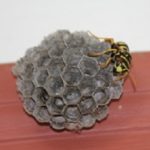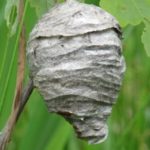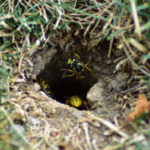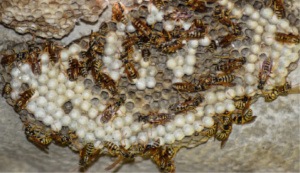Wasps Nest Identification
Do you have a wasps nest or are they beneficial bees? The term Wasps covers most flying, stinging insects that are not bees. Some species of ants also fly and sting, but they are rare and easier to differentiate from wasps. Not all wasps live in colonies and not all wasps are aggressive, for instance, the great golden digger wasp and mud daubers. This is why you need an expert to identify the species.
Bees swarm to build their hive. If you see a swarm hanging from a branch or rafter, they are most likely bees in need of rehoming.
Wasps swarm in defense of an existing nest or away from the nest when gathering food. If you see a wasps nest, and it is, therefore, unsafe to enjoy your property, you'll want immediate professional removal.
Wasp Removal Services Near You
Get a Croach® pest exterminator near:
- Seattle (including Mukilteo, Sumner, Kirkland, Tacoma, Mount Vernon) and Tri-Cities, Washington.
- Spokane, Post Falls, Kooskia, Lewiston, and Boise, Idaho.
- Portland, Beaverton, Oregon.
- Denver, Aurora, Colorado.
- Columbia and Greenville, South Carolina.
- Charlotte, North Carolina
- Salt Lake City, Sandy, Utah.
Wasps Nests
Three Primary Types

1. Solitary, parasitic wasps, paper wasps, and some others build umbrella nests. They hang from rafters, eaves, and branches.
Looking up you will see the hexagonal cells, or combs, visible from underneath. The exterior looks like gray paper.

2. Hornets, bald-faced hornets (a type of yellow jacket), and German wasps build nests that look like large footballs or upside-down teardrops.
They have a single entrance hole in the bottom and also appear to be made of gray paper.

3. Yellow Jackets build nests underground and in hollow spaces. Like wall voids and cupboards.
You can identify them by an entry with yellow jackets going in and out. Some parasitic wasps inhabit underground nests of other insects and animals.
Characteristics
To begin, a queen gathers fibrous material and mixes it with her saliva. The queen scrapes wood from homes, trees, fences, and even cardboard. No matter which type, the nest begins as a hanging node which the queen builds out into cells to lay eggs.
 Future generations take over building the nest to fit the size of the colony. At the height of the season, it contains thousands of wasps. They will aggressively sting and bite to defend their home. A wasp sting is painful and can become life threatening.
Future generations take over building the nest to fit the size of the colony. At the height of the season, it contains thousands of wasps. They will aggressively sting and bite to defend their home. A wasp sting is painful and can become life threatening.
At the end of the summer only fertilized queens survive, overwintering outside of the nest. The nest is delicate at this point. It will break down before spring. Some tropical wasps survive the winter, building multi-year nests. In the U.S., only southern yellow jackets can do so.
Wasp Nest Removal
Wasp nest removal should be done by a pest control professional.
Croach® technicians are trained to deal with these aggressive insects. After treatment, umbrella nests and teardrop nests are knocked down and removed.
Ground nests will remain empty for the rest of the season and deteriorate naturally. You will want to seal them up before the next spring. Wasps are notorious for returning to the same spots year after year.
Your technician will also advise you on actions to make your yard less appealing. Schedule a free inspection for wasp removal or to get rid of wasps and other unwanted pests at your home.
Free Pest Inspection
